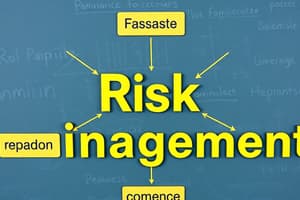Podcast
Questions and Answers
What is a primary characteristic of direct losses to property?
What is a primary characteristic of direct losses to property?
- They result from indirect causes
- They only apply to business assets
- They stem from physical damage, destruction, or theft (correct)
- They are limited to theoretical damage
What best describes an indirect loss?
What best describes an indirect loss?
- A financial loss resulting from the direct damage's aftermath (correct)
- A loss related only to physical injuries
- A loss not associated with property at all
- A risk that has no financial impact
Which of the following risks can significantly impact a business if they occur?
Which of the following risks can significantly impact a business if they occur?
- Short employee absences
- Liability risks (correct)
- Routine maintenance costs
- Minor equipment failure
Which one of these is NOT considered a burden of risk on society?
Which one of these is NOT considered a burden of risk on society?
What is the main purpose of risk control techniques?
What is the main purpose of risk control techniques?
Which of the following is a method of risk financing?
Which of the following is a method of risk financing?
What is a significant challenge encountered in understanding risks?
What is a significant challenge encountered in understanding risks?
How does variability in outcomes affect risk assessment?
How does variability in outcomes affect risk assessment?
What characterizes uncertainty in decision-making?
What characterizes uncertainty in decision-making?
How is risk defined in relation to probability?
How is risk defined in relation to probability?
Which of the following techniques is NOT commonly used for effective decision-making under uncertainty?
Which of the following techniques is NOT commonly used for effective decision-making under uncertainty?
What is a key characteristic of variability in outcomes related to uncertainty?
What is a key characteristic of variability in outcomes related to uncertainty?
Which of the following best describes ambiguity in data?
Which of the following best describes ambiguity in data?
What is the fundamental aspect that contributes to the dynamic nature of uncertainty?
What is the fundamental aspect that contributes to the dynamic nature of uncertainty?
In risk management, what is the purpose of employing techniques such as sensitivity analysis?
In risk management, what is the purpose of employing techniques such as sensitivity analysis?
Which of the following statements about risk is FALSE?
Which of the following statements about risk is FALSE?
What characterizes dynamic risks?
What characterizes dynamic risks?
Which type of risk may cause a company to incur financial loss due to unexpected market changes?
Which type of risk may cause a company to incur financial loss due to unexpected market changes?
Which of the following is an example of non-financial risk?
Which of the following is an example of non-financial risk?
How does variability in outcomes relate to risk management?
How does variability in outcomes relate to risk management?
What is a fundamental risk recognized in risk classification?
What is a fundamental risk recognized in risk classification?
Which type of risk is primarily associated with unpredictable events not affecting overall financial health?
Which type of risk is primarily associated with unpredictable events not affecting overall financial health?
What aspect of risk management does ambiguity in data affect the most?
What aspect of risk management does ambiguity in data affect the most?
What defines speculative risks in comparison to pure risks?
What defines speculative risks in comparison to pure risks?
Study Notes
Major Personal Risks
- Premature death of a family head can lead to significant financial strain.
- Inadequate retirement income poses a risk to financial stability in later years.
- Poor health can result in high medical costs and loss of income.
- Unemployment disrupts financial plans and may lead to default on obligations.
- Alcohol and drug addiction creates financial and social difficulties.
Types of Financial Losses
- Direct loss refers to tangible financial loss from physical damage or theft of property.
- Indirect loss, or consequential loss, includes losses from loss of use, profits, rents, and extra expenses arising from direct losses.
- Liability risks have no upper limit; losses can exceed available assets and incur additional legal costs.
Business Risks
- Various risks can jeopardize business viability, including:
- Property risks related to physical assets.
- Liability risks from legal claims.
- Loss of business income due to operational interruptions.
- Crime risks, such as theft or fraud.
Societal Burdens of Risk
- Increased emergency fund requirements to manage unforeseen losses.
- Loss of goods and services impacts societal overall productivity and availability.
- Psychological effects of worry and fear from potential risks.
Risk Control Techniques
- Risk control encompasses strategies to reduce loss frequency or severity, including:
- Avoidance: eliminating risk entirely.
- Loss prevention: reducing the likelihood of loss.
- Loss reduction: minimizing impact when loss occurs.
- Duplication: having backups in place.
- Separation: dispersing assets to minimize total loss.
- Diversification: spreading risk across different areas.
Risk Financing Techniques
- Funding losses after occurrence is achieved through:
- Retention: accepting some risk personally.
- Noninsurance transfers: shifting risk to another party without insurance.
- Insurance: purchasing coverage to mitigate financial impact.
Health Perils
- Health-related risks include personal well-being events such as:
- Illness and disease (e.g., infections, chronic conditions).
- Accidents and injuries (e.g., slips, falls).
Risk Classification
- Risks can be categorized in multiple ways:
- Financial vs. non-financial risks.
- Dynamic (economy-related changes) vs. static risks (unchanging).
- Pure (insurable events) vs. speculative risks (involving profit potential).
- Fundamental (widespread) vs. particular risks (specific to an individual or organization).
Important Aspects of Risk
- Risk exists as a real world condition and presents uncertain outcomes.
- The probability of loss ranges from 0 (impossible) to 1 (certain due to death).
- All risks involve potential loss but lack a defined measurement requirement.
Understanding Uncertainty
- Uncertainty stems from unpredictability about future events, influencing decision-making.
- Sources of uncertainty include economic shifts, technological progress, regulatory changes, and natural disasters.
- Decision-making strategies under uncertainty can involve scenario planning, sensitivity analysis, or expert judgment to manage potential risks effectively.
Studying That Suits You
Use AI to generate personalized quizzes and flashcards to suit your learning preferences.
Related Documents
Description
Test your knowledge on major personal risks that individuals face, including factors like inadequate retirement income, health issues, and unemployment. This quiz also covers concepts of direct and indirect financial losses related to property. Understand how these risks can impact financial stability.





